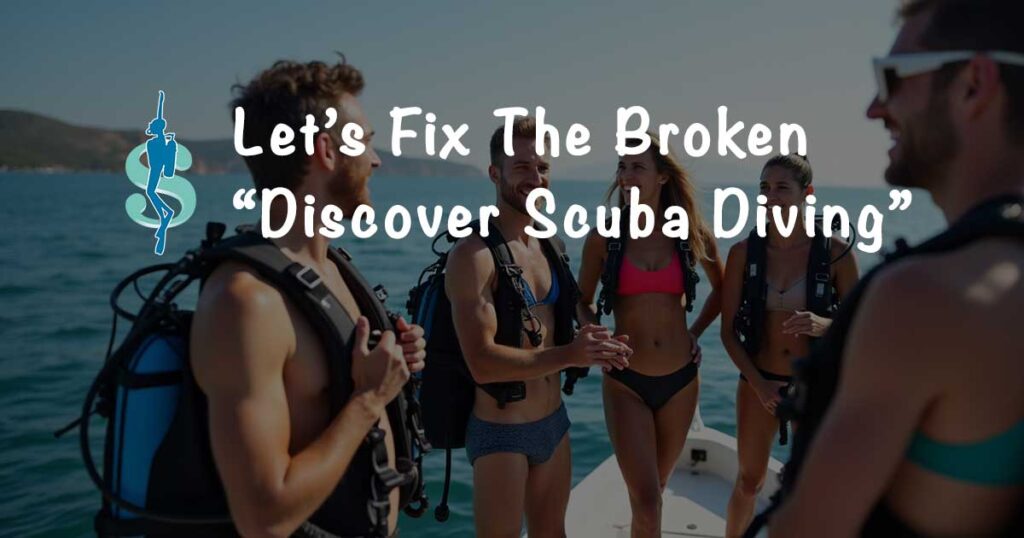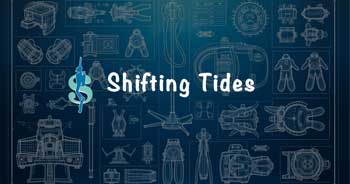Should We Change the Way We Provide “Discover Scuba Diving” Experiences?
Thinking outside the box to improve the quality of the scuba diving experience and generate adepts of the underwater world coming back to us over and over again.
The famous discover scuba diving (DSD) or scuba tryout… It is a peculiar beast.
One of its purposes is to be a money-making activity for numerous resorts. The number of scuba tryouts done annually around the planet is significantly higher than the number of entry-level certifications - somewhere between 6 and 10 times more.
The second role of discover scuba diving (DSD) is to be a marketing tool we use to provide to people a chance to taste the underwater world, in the hope of recruiting students for the open water (entry-level) diver course.
In this article, I will discuss how DSD is failing in both of these goals, and then, I will discuss two possible solutions: improving or replacing it.
In the following article, I will be using data from the USA for illustration purposes, but the same principles apply in numerous other scuba diving markets.
This post is part of our Shifting Tides: Dive Industry Assessment & Strategies for Today’s Scuba Divers series by the Business of Diving Institute and Darcy Kieran, author of:
Table of Contents
How is Discover Scuba Diving a Failure as a Marketing Tool?
Here’s a real-life story from a team in an urban dive store.
A few years back, as a marketing initiative, their training agency shared with them, monthly, the list of people who had done a scuba tryout the month before, somewhere on the planet.
Their first observation was that the number of such people was tremendous. The monthly list of scuba tryout participants was often twice as long as the number of entry-level certifications they were doing, annually – and they were the largest dive center in their area. This list only included scuba tryout sessions reported to the training agency by dive instructors or dive resorts. Many people try scuba on vacation without the instructor notifying the dive training agency.
The owner of that dive center hired a marketing person dedicated to following up on these people. He thought he had found fortune! That was before he started contacting these people and realized that the number of negative responses they got was out of this world.
The vast majority (70%+) of people they called told them about an awful experience. These scuba tryout participants didn’t want to even think about scuba diving again.
The person hired to contact these people heard horror story after horror story. A guy who ended up with a free-flowing regulator at 110 feet on the open water portion of the scuba tryout adventure. A gal who had a BCD leaking air and had to constantly “swim up” not to be sinking. Another guy who couldn’t keep up with the divemaster swimming ahead like he was in a Formula One race. Another gal who panicked when her mask flooded, and nobody cared. And these stories kept on coming.
They eventually stopped the initiative. There were just so few people interested in pursuing scuba diving after doing a scuba tryout that it wasn’t worth making these phone calls.
Of course, their sample only included people from the geographic region their dive shop was located in, but the sample size was quite large after numerous months of following up and trying.
In the face of such dismal results, we can no longer pretend that a discover scuba diving is a good way to get people into scuba diving. Well, let me rephrase this.
The way we currently perform scuba tryouts fails at getting people to appreciate scuba diving. On the contrary, we scare them away.
This brings us to our prior discussion on the inconsistency of the quality of the experience in the dive industry. Part of the problem could be fixed with quality assurance – real quality assurance. But there’s more to it than that as we will discuss below.
Of course, in the ‘following up’ initiative, a minority of scuba tryout participants had a good time breathing underwater for the first time. But in those cases, they found that many people just wanted to do it once, and now it was “done.” In other words, they wanted to cross it off their bucket list.
So, either way, these scuba tryouts are just a way for resorts to make money from tourists – but they do not produce much value as a marketing technique to recruit clients in the dive industry. To grow the scuba diving industry, we need to rethink these experiences and our marketing approaches.
DSD as a Profit Center is Also a Failure
Even for those dive centers and instructors offering DSDs as a profit center, not as a marketing tool to recruit open water scuba diving students, the results are… Dangerous!
Do you know of many companies in the “experience economy” that are growing when they provide a highly questionable experience? It is no way to run a business and, even less, to grow one. And that is what we see… A shrinking dive industry.
Think about this: Every year, about 150 thousand Americans get their entry-level scuba certifications. Meanwhile, millions of Americans are participating in scuba tryouts around the world. Millions. Yet, the number of active scuba divers in the USA has been declining for years.
Based on these facts, the conclusion is pretty dramatic.
Every year, we introduce millions of people to scuba diving and every year, we lose more than that!
So this is how the scuba diving market looks in the USA:

Some people will tell you that our dropout rate is “not that bad,” but that is because they calculate it only on the number of new entry-level scuba diving certifications issued. The fact is that people who did a discover scuba diving were also introduced to scuba diving, and if they decide never to dive again, they are dropouts.
If we were to reduce our dropout rate by half, the dive industry would be growing by 60%, annually!
The outdoor industry is booming. Scuba diving is not. We need to fix this.
How Do We Fix Discover Scuba Diving?
I am sure we could brainstorm numerous solutions, but one thing is sure, we need a solution because it is, statistically, the single biggest hurdle to the growth of the scuba diving industry.
Solution One: Improve The Quality of The Experience
This goes without saying. We have a bad track record. Too many people leave their scuba diving experience with a bad feeling. We cannot grow a business, nor an industry, like that.
To improve the quality of the experience, we need to implement the needed real quality assurance – not just on the respect of teaching standards, but on the consistency of the quality of the experience.
Another step would be to change the standards to make it more probable that the person trying to breathe underwater for the first time has a good experience. In that regard, I have to praise SDI for applying an instructor to diver ratio of 2:1 in their Scuba Discovery Program. As Stephanie told me: “Two hands, two divers.”
Is it less profitable to do a scuba tryout with only 2 divers instead of 4? In the short term, with the same pricing, you are right. In the long run, providing a better experience can only pay off.
Otherwise, I question “who” should be allowed to offer DSDs. It is more dangerous to guide a scuba tryout than to teach a boat diver specialty! Only experienced dive instructors should take care of bringing underwater people who are untrained and diving for the first time. Yet, we usually see the latest instructor graduate thrown to the wolves because experienced instructors have more fun things to teach. It’s backward thinking.
In fact, even our entry-level open water diver course is questionable. Four dives are rarely enough for new divers to be comfortable in a new environment, wearing a new kind of equipment. Fixing our dropout rate and putting our industry back on a path to growth will require more than just fixing our scuba tryouts. We also need to have a look at how we provide entry-level scuba diving certifications.
Solution Two: Cancel Discover Scuba Diving
“Insanity is doing the same thing over and over again and expecting different results.”
We are insane! Time to go back to the drawing board.
Let’s take a step back. What are we really trying to do? We want to give people a way to experience the underwater world. In that sense, scuba is just a tool like a fork in a restaurant. Let’s sell the menu, first!
Let’s say we could find a way to introduce people to the underwater world, in an easier way. Once people are in awe of the underwater world, taking on scuba diving to see more of it will be a much more natural step – a step in which we could then take the time to do properly instead of simply doing some tea-bagging and scaring them off!
That is what I asked earlier: Is there a way for more people to explore the underwater world before (or instead of) grabbing challenging scuba gear?
Let’s start somewhere. I have one such solution to propose: Surface-supplied air diving.
I actually stole this idea from an instructor who contacted me after I wrote an introductory article on surface-supplied air (SSA). He told me that instead of using scuba for his try-out dives, he uses SSA units. And here is the kicker: He said that his conversion rate (how many divers went from trying out to taking on a scuba certification course) went up!
Are we too snob to look at this option because it is not, technically, scuba? It is not a “self-contained” underwater breathing apparatus, but it is still an underwater breathing apparatus, one that is a lot easier to use and less scary for a new diver.
If we focus on the experience of the underwater world, we can find better ways to offer these experiences.
I also got contacted by dive instructors who told me that since they switched to SSA for offering these types of experience, their profitability went up. They are selling “discover the underwater world,” not “discover scuba.” And if somebody asks about scuba, they point out that it is the same type of regulator and answer all their questions.
Furthermore, not everybody needs to be a scuba diver. There will always be more snorkelers than divers; perhaps there is a middle-step between being a snorkeler and being a scuba diver that is just enjoyable “as is.” SSA can be a “snorkeling+” option for snorkelers who want to see the reef more closely without taking on a full scuba diving course.
In Summary
The idea is pretty simple.
Every year, we are introducing millions of people to the underwater world. They come to us excited about it. Nobody woke up one morning thinking, “I’ve always wanted to have a terrible experience.” They think they will enjoy themselves when they come to see us. But afterward, they never do it again.
The only thing between their excitement to do it and their move away from it, is us. They spent time with us. We scared them away. So, let’s fix what we do and/or find alternatives.
Continue reading about Shifting Tides: Scuba Diving Industry Assessment & Strategies for Today’s Scuba Divers.
If you found the information on this page valuable, would you consider buying me a coffee?
Either way, let’s work together on “raising the bar” in the dive industry to satisfy today’s consumers!
Your Dive Industry Compass
Scuba Diving Market Research, Surveys, Reports & Statistics
Shifting Tides
Strategies for Today’s Scuba Divers
Living The Scuba Dream
Plan Your Scuba Instructor Career & Deep Dive the Plan
You may also be interested in The Immersion Zone (our podcast), Scubanomics (our newsletter for dive professionals), and our published books & reference guides.





